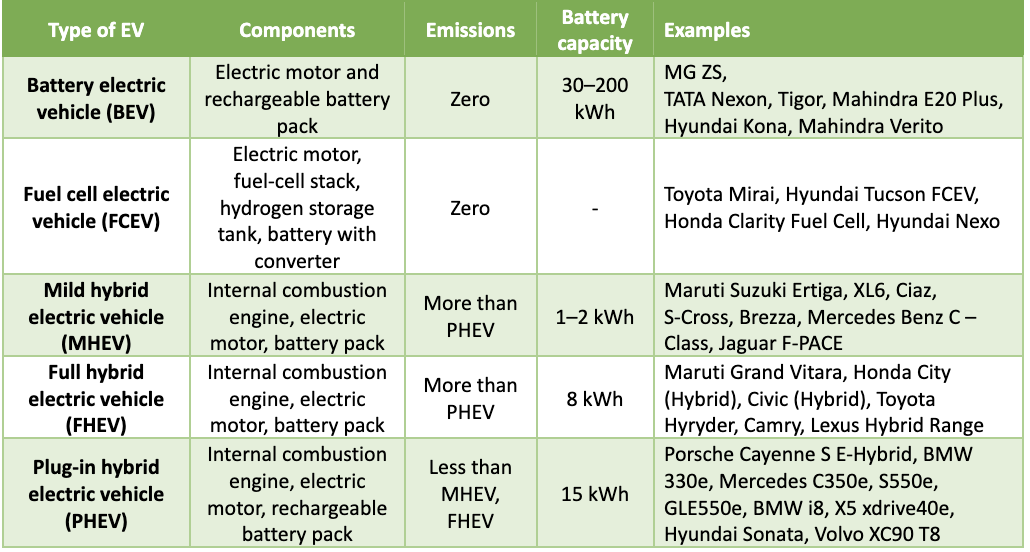Context
The sales of electric vehicles (EVs) in the Indian automobile market have grown exponentially in recent years. EVs, across categories (E-2W, E-3W, E-4W, etc.), recorded sales volumes in FY22 that were almost three times that of the previous year. Specifically, for E-4W, there are several different types available in the Indian market:
Figure 1:Types of E-4W

Source: CEEW CEF Compilation.
Battery electric vehicles (BEVs)
BEVs are those EVs that are powered only by electricity. The main components are electric motors and rechargeable battery packs, which power the entire system. BEVs work on the principle of converting chemical energy from the battery pack to electrical energy, which then powers the electric motor that produces the mechanical thrust to push the car forward. Some BEVs also have a unique mechanism to charge battery packs called regenerative braking. It is based on the principle of converting kinetic energy to electrical energy. BEVs do not produce direct exhaust or tailpipe emissions like internal combustion engine (ICE) vehicles. Since they have motors and battery packs, they are usually heavier than ICE vehicles and produce more torque.
Fuel cell electric vehicles (FCEVs)
FCEVs operate primarily on electricity, but the power is produced from pure hydrogen gas. As a result, there are no direct exhaust or tailpipe emissions. In this respect, they are very similar to BEVs. However, an additional component that FCEVs have when compared to BEVs is the hydrogen tank, much like petrol and diesel fuel tanks in ICE vehicles.
Hybrid electric vehicles (HEVs)
HEVs are vehicles that are powered by both electricity and conventional fuel. They feature aspects of both electric motors as well as ICEs. HEVs produce tailpipe emissions but lesser than what ICE vehicles produce. They also offer higher fuel economy, more power, and a driving range – all of which are significant advantages over BEVs and ICE vehicles. HEVs often feature regenerative braking for recharging their batteries. There are three different kinds of HEVs available in the market:
- Mild hybrid electric vehicles (MHEVs): MHEVs have both ICEs and electric motors, but the electric motors cannot work independently to power the vehicle. They work together to optimise fuel economy and reduce emissions. The electric system usually helps with auto start and stop and is charged using regenerative braking. These vehicles are generally affordable but have less fuel economy compared to full hybrids.
- Full hybrid electric vehicles (FHEVs): FHEVs have larger batteries and powerful motors. Hence, they can work independently of the ICE. The electric system has enough energy to power the vehicle for short distances at low speeds. This makes it better suited as a city vehicle.
- Plug-in hybrid electric vehicles (PHEVs): As the name suggests, PHEVs are hybrid vehicles with rechargeable battery packs like BEVs, which can be charged through an external power source. They usually have the highest battery capacity compared to all other hybrid vehicles. They can operate entirely as BEVs for short distances, hence reducing tailpipe emissions to zero for that duration.
Table 1:Types of E-4W with their components, emissions, battery capacity and examples

Source: CEEW CEF Compilation.



